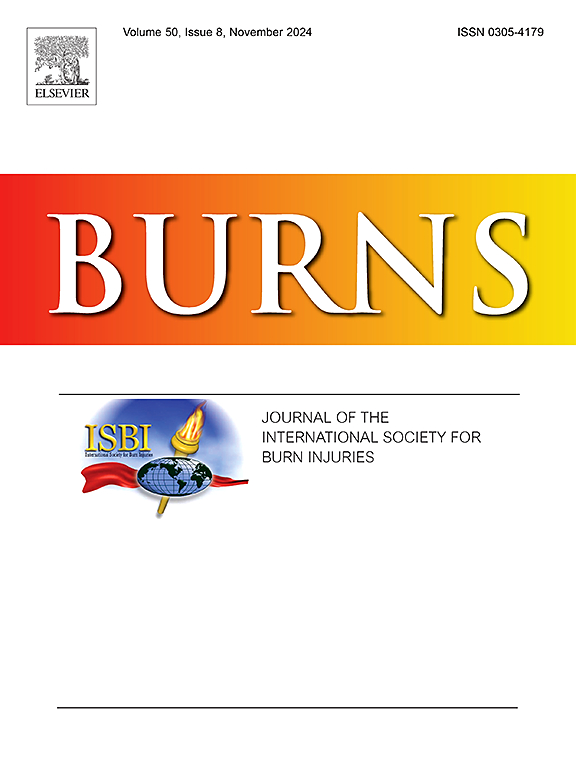烧伤后的长期睡眠障碍:来自烧伤模型系统的见解
IF 2.9
3区 医学
Q2 CRITICAL CARE MEDICINE
引用次数: 0
摘要
目的利用烧伤模型系统(BMS)国家数据库在全国范围内对成人烧伤幸存者睡眠障碍(SD)的患病率及相关因素进行全面调查,以解决对其认识不足的问题。dataSD是一种常见但尚未被充分研究的烧伤后遗症,它对烧伤幸存者的生活质量和功能的影响远远超出了最初的损伤。关于这些患者的SD及其合并症的现有数据仅限于选择单机构研究,缺乏全面的全国视角。方法查询BMS国家数据库,确定烧伤患者在伤后6个月、12个月、2年和5年对sd相关问题的回答。通过描述性统计、亚组分析和混合效应建模来评估不同时间点SD的患病率、进展和相关因素。结果558例成人烧伤幸存者符合纳入标准。在受伤后6个月,34 %的参与者报告SD, 31 %的参与者在5年仍然受到影响。人口统计学特征(年龄、性别、种族)和临床特征(体重指数(BMI)、烧伤总体表面积(TBSA))不能显著预测SD的风险。混合效应模型表明,较高的SD分数与较高的抑郁和焦虑分数之间存在显著关联。结论ssd在烧伤幸存者中是一种持续性疾病,其患病率可持续至伤后5年。我们的研究强调了无法根据人口统计学和临床因素预测SD,强调了普遍筛查和干预的必要性。此外,SD、抑郁和焦虑之间的联系要求采用综合护理方法,解决烧伤患者的心理和身体恢复问题。本文章由计算机程序翻译,如有差异,请以英文原文为准。
Long-term sleep disturbance following burn injury: Insights from the Burn Model System
Objective
To address the limited understanding of sleep disturbance (SD) among adult burn survivors by comprehensively examining its prevalence and related factors on a national scale using the Burn Model System (BMS) National Database.
Summary background data
SD is a common but underexplored sequela of burn injury, affecting burn survivors’ quality of life and functionality well beyond the initial injury. Existing data on SD and its co-morbidities in these patients are limited to select single-institution studies, lacking a comprehensive national perspective.
Methods
The BMS National Database was queried to identify burn patients responding to SD-related questions at 6 months, 12 months, 2 years, and 5 years post-injury. Descriptive statistics, subgroup analyses, and mixed-effects modeling were conducted to evaluate the prevalence, progression, and associated factors of SD at different time points.
Results
558 adult burn survivors met inclusion criteria. At 6 months post-injury, 34 % of participants reported SD, with 31 % still affected at 5 years. Demographic characteristics (age, gender, ethnicity) and clinical characteristics (body mass index (BMI), total body surface area burned (TBSA)) could not significantly predict the risk of SD. Mixed-effects modeling demonstrated a significant association between higher SD scores and increased depression and anxiety scores.
Conclusions
SD is a persistent condition among burn survivors, with prevalence continuing up to 5 years post-injury. Our study highlights the inability to predict SD based on demographic and clinical factors, underscoring the need for universal screening and interventions. In addition, the association between SD, depression, and anxiety calls for an integrated care approach that addresses both psychological and physical recovery in burn patients.
求助全文
通过发布文献求助,成功后即可免费获取论文全文。
去求助
来源期刊

Burns
医学-皮肤病学
CiteScore
4.50
自引率
18.50%
发文量
304
审稿时长
72 days
期刊介绍:
Burns aims to foster the exchange of information among all engaged in preventing and treating the effects of burns. The journal focuses on clinical, scientific and social aspects of these injuries and covers the prevention of the injury, the epidemiology of such injuries and all aspects of treatment including development of new techniques and technologies and verification of existing ones. Regular features include clinical and scientific papers, state of the art reviews and descriptions of burn-care in practice.
Topics covered by Burns include: the effects of smoke on man and animals, their tissues and cells; the responses to and treatment of patients and animals with chemical injuries to the skin; the biological and clinical effects of cold injuries; surgical techniques which are, or may be relevant to the treatment of burned patients during the acute or reconstructive phase following injury; well controlled laboratory studies of the effectiveness of anti-microbial agents on infection and new materials on scarring and healing; inflammatory responses to injury, effectiveness of related agents and other compounds used to modify the physiological and cellular responses to the injury; experimental studies of burns and the outcome of burn wound healing; regenerative medicine concerning the skin.
 求助内容:
求助内容: 应助结果提醒方式:
应助结果提醒方式:


